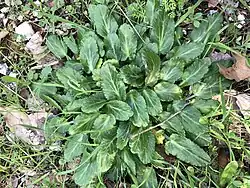Eryngium creticum
| Eryngium creticum | |
|---|---|

| |

| |
| Eryngnium creticum flowers | |
| Scientific classification | |
| Kingdom: | Plantae |
| Clade: | Tracheophytes |
| Clade: | Angiosperms |
| Clade: | Eudicots |
| Clade: | Asterids |
| Order: | Apiales |
| Family: | Apiaceae |
| Genus: | Eryngium |
| Species: | E. creticum
|
| Binomial name | |
| Eryngium creticum | |
Wikimedia Commons has media related to Eryngium creticum.
Eryngium creticum, or the field eryngo, is a species of flowering plant in the family Apiaceae native to Greece, Israel, Jordan, Lebanon and Syria. It is known in Lebanon as قرصعنة and in Israel as חרחבינה מכחילה.[1]
Description
It is pollinated by bees, beetles and flies, and tolerates poor soil. It is self-fertile and requires minimal water.[2] The plant is found from October to April and blooms from April to August.[1]
Etymology
The name creticum refers to the island of Crete.
Uses
The plant is used medicinally. Its stems are used to make an anti-tussive tea that is also used for kidney inflammation. It is also used as a remedy for scorpion stings in Jordan and to treat hypoglycemia.[3]
References
- ^ a b "Plants in Israel: Field Eryngo".
- ^ "Plant database entry for Eryngium creticum with 5 images and 8 data details".
- ^ Jaghabir, Madi (1991). "Hypoglycemic effects of Eryngium creticum". Archives of Pharmacal Research. 14 (4): 295–297. doi:10.1007/BF02876873. S2CID 71408657.